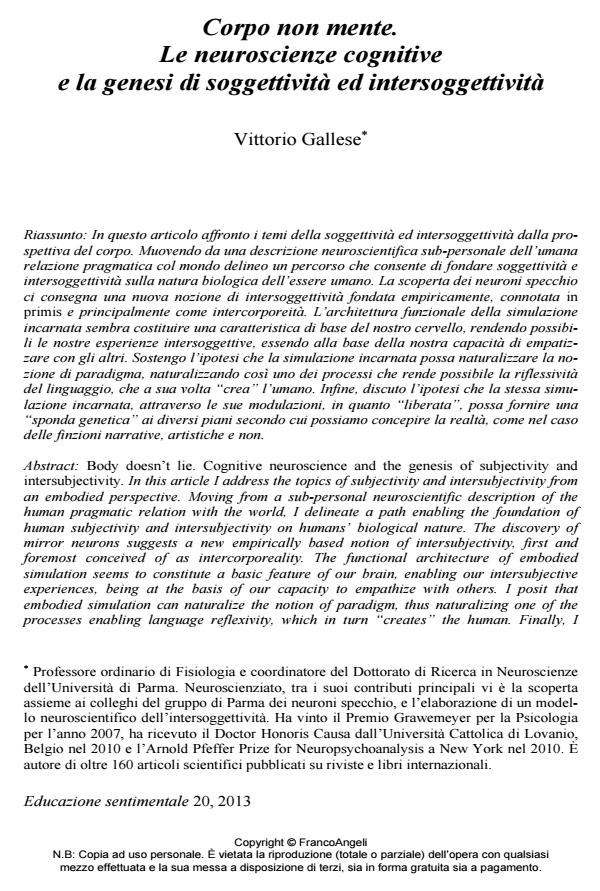Corpo non mente. Le neuroscienze cognitive e la genesi di soggettività ed intersoggettività
Journal title EDUCAZIONE SENTIMENTALE
Author/s Vittorio Gallese
Publishing Year 2013 Issue 2013/20
Language Italian Pages 17 P. 8-24 File size 671 KB
DOI 10.3280/EDS2013-020002
DOI is like a bar code for intellectual property: to have more infomation
click here
Below, you can see the article first page
If you want to buy this article in PDF format, you can do it, following the instructions to buy download credits

FrancoAngeli is member of Publishers International Linking Association, Inc (PILA), a not-for-profit association which run the CrossRef service enabling links to and from online scholarly content.
Body doesn’t lie. Cognitive neuroscience and the genesis of subjectivity and intersubjectivity. In this article I address the topics of subjectivity and intersubjectivity from an embodied perspective. Moving from a sub-personal neuroscientific description of the human pragmatic relation with the world, I delineate a path enabling the foundation of human subjectivity and intersubjectivity on humans’ biological nature. The discovery of mirror neurons suggests a new empirically based notion of intersubjectivity, first and foremost conceived of as intercorporeality. The functional architecture of embodied simulation seems to constitute a basic feature of our brain, enabling our intersubjective experiences, being at the basis of our capacity to empathize with others. I posit that embodied simulation can naturalize the notion of paradigm, thus naturalizing one of the processes enabling language reflexivity, which in turn "creates" the human. Finally, I discuss the hypothesis that embodied simulation through its modulations, once "liberated", might generate the different levels characterizing the way we conceive of reality, like in the case of artistic and non artistic fictional narratives.
Keywords: Art, embodied simulation, empathy, intersubjectivity, language, mirror neurons, paradigm, subjectivity.
- Le due porte d'ingresso dell'ipnosi nelle dipendenze patologiche: l'alessitimia e la memoria del piacere Nicolino Rago, Federica Volpi, Mario Marazzi, in IPNOSI 1/2021 pp.27
DOI: 10.3280/IPN2021-001002 - Goldman and His Critics Vittorio Gallese, pp.297 (ISBN:9780470673676)
- Il corpo paradigmatico. Simulazione incarnata, intersoggettività, Sé corporeo e linguaggio Vittorio Gallese, Valentina Cuccio, in SETTING 43/2020 pp.5
DOI: 10.3280/SET2020-043001 - Empathy Vincenzo Auriemma, pp.89 (ISBN:978-3-031-38859-0)
- Neurochange. Dall'antropologia culturale alle neuroscienze. Un'ipotesi di lavoro e un caso di studio supportato dall'utilizzo delle rilevazioni neurometriche, per la gestione dei processi di cambiamento nelle istituzioni economiche e sociali Massimilano Santoro, in RICERCHE DI PSICOLOGIA 3/2017 pp.313
DOI: 10.3280/RIP2017-003003 - Phenomenology of Suicide Davide Donelli, Matteo Rizzato, pp.73 (ISBN:978-3-319-47975-0)
- Dare voce al soggetto. Materiali tratti dall’osservazione longitudinale di un bambino autistico Maria Pediconi, Luca Regini, in Ricerca Psicoanalitica /2021
DOI: 10.4081/rp.2021.313 - Intrecci e metamorfosi fra passato, presente e futuro: l'approccio ecologico sociale e umano agli eventi di natura traumatica, ai processi di resilienza e alla resilienza assistita Elena Malaguti, in RIVISTA SPERIMENTALE DI FRENIATRIA 3/2016 pp.83
DOI: 10.3280/RSF2016-003007 - Lifelong Learning - Education for the Future World Paola Damiani, Davide Brancato, Filippo Gomez Paloma, (ISBN:978-0-85014-117-7)
- L'uso delle immagini e della fotografia nella psicoterapia della Gestalt. Neuroestetica, neuroni specchio e risonanza corporea Michele Cannavò, Jelena Zeleskov Doric, Alessandro Cereda, Azzurra G.M. Alù, in QUADERNI DI GESTALT 2/2021 pp.29
DOI: 10.3280/GEST2021-002003 - Embodied intersubjectivity: Forms of psyche-soma structuring in the encounter between self and other-than-self* Anna Ferruta, Maurizio Stangalino, in The International Journal of Psychoanalysis /2024 pp.455
DOI: 10.1080/00207578.2024.2362807 - More than spectators, visionaries Laura Marcolini, in AN-ICON. Studies in Environmental Images [ISSN 2785-7433] /2024 pp.97
DOI: 10.54103/ai/25154
Vittorio Gallese, Corpo non mente. Le neuroscienze cognitive e la genesi di soggettività ed intersoggettività in "EDUCAZIONE SENTIMENTALE" 20/2013, pp 8-24, DOI: 10.3280/EDS2013-020002